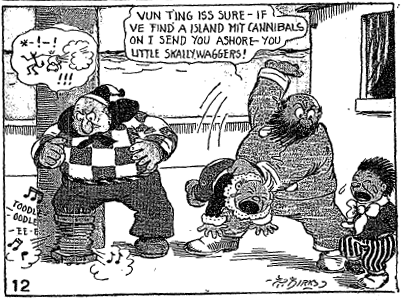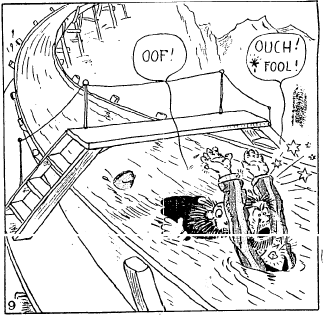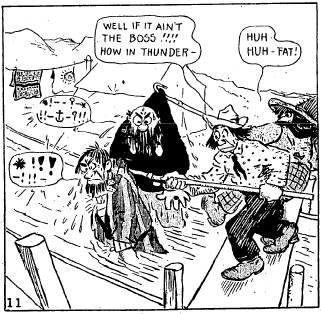Obscenicons a century ago
« previous post | next post »
Mark Liberman recently asked, "What was the earliest use of mixed typographical symbols (as opposed to uniform asterisks or underlining) to represent (part or all of) taboo words?" The use of such symbols appears to have originated as a comic-strip convention. Comic strip fans, following Mort Walker's Lexicon of Comicana, have often called these cursing characters grawlixes, though I prefer the term obscenicons. In Gwillim Law's history of grawlixes, he lists examples of cartoon cursing going back to the Sep. 3, 1911 installment of "The Katzenjammer Kids." Here is the panel in question (which I found in the Washington Post archives):

Along with a sequence of asterisk-dash-exclamation point-dash-exclamation point, the speech balloon also features what appears to be a stick-figure devil firing a cannon, with three more exclamation points for good measure. As delightful as this example is, it's not the earliest use of obscenicons on the comics page. I found another "Katzenjammer Kids" strip using them, from two years earlier.
Skimming through comics pages in the newspaper databases, I discovered the "Kids" strip of Aug. 8, 1909 (as printed in The Atlanta Constitution), with the title, "One of Those Dod Gasted Lumber Flumes!" (Dod gasted is a minced oath along the lines of dad-blasted, in the strip's stereotypically German-accented style.) The Captain takes the Kids, Hans and Fritz, to see a log flume, and before too long the Kids have pushed the Captain and the flume owner, Diamond Joe, into the water. Diamond Joe exclaims, "Ouch!" followed by "* fool!", with lines around the asterisk.

But when the Captain and Diamond Joe are finally fished out of the water, they both unleash a flurry of obscenicons (the Captain's sequence even includes an anchor symbol):

(You can see the whole strip here.)
Since "The Katzenjammer Kids" often portrayed Hans and Fritz mischievously tormenting adults, who then react with cartoonish rage, it's quite likely that earlier obscenicons can be found in the strip's history. Credit "Kids" creator Rudolph Dirks, then, with being the true pioneer of typographically innovative taboo-word substitution.
[Update, July 24: See this follow-up post for obscenicons going back to 1902.]
Stan said,
July 17, 2010 @ 3:56 pm
Wonderful! I would suffer a keyboard twice the normal size if it offered an array of obscenicons (and a way to add my own).
Trond Engen said,
July 17, 2010 @ 4:47 pm
Note that all invectives are asterisked as hypothetical forms.
Moritz said,
July 17, 2010 @ 4:53 pm
As far as the simple obscenicons of Katzenjammer Kids go, Unicode has got you covered, including everything from heavy exclamation marks and to stars and even an anchor. There's also the popular lightning symbol… Sadly no stick figure devil firing a cannon, though, politics I guess!
Here's my rendition of the captains utterance: ✖! — – ? ✱!! — ⚓ – ?!!
mollymool said,
July 17, 2010 @ 5:47 pm
"The use of such symbols appears to have originated as a comic-strip convention."
Has it progressed much beyond comic strips? One sees it in online ephemeral texts, but I would interpret that as alluding to the comics rather than extending the scope of the convention.
[(bgz) No, it hasn't progressed much further. But if obscenicons can work their way into country music, the sky's the limit.]
Mr. Fnortner said,
July 17, 2010 @ 8:16 pm
Fun fact: You can use obscenicons in your passwords to harden them, eg, "safe#@$9X". They are much more unexpected than numbers or capital letters.
Lance said,
July 17, 2010 @ 9:04 pm
Has it progressed much beyond comic strips?
Well, CBS has the upcoming series $#*! My Dad Says. It's clearly using the same basic idea of "typographical symbols in place of obscenities", but unlike in (most?) comic strips, it's not a random series of typographical symbols: $ is used for S, # for H, and ! for T, as those are relatively close in shape. "$#!+" would probably be closer, which makes me suspect that they turned the obscenity "shit" into "sh*t", and then turned that into symbols.
That sort of typographical replacement is probably not uncommon, though it's hard to search the web for, thanks to the way Google ignores punctuation. I'd expect a number of hits for "a$$hole", but could only turn up http://www.reddit.com/r/reddit.com/comments/chuz8/what_an_ahole_sorry_reddit_first_thing_out_of_my/ and http://forums.klipsch.com/forums/p/32015/274389.aspx , by searching for "a dollar sign dollar sign hole". (Which I don't think is going to become as common as "H-E-double-hockey-sticks" any time soon.)
[(bgz) Geoff Pullum commented on $#*! My Dad Says a few days ago. And back in 2005, Arnold Zwicky noted a cinematic use: What the #$*! Do We Know!?]
marie-lucie said,
July 18, 2010 @ 12:12 am
Some years ago a missionary (I think) invented a new alphabet for a hitherto poorly recorded language of British Columbia. The alphabet was phonemically accurate, but there was one problem: some of the distinctive phonemes were represented by asterisks, dollar signs, etc, the whole panoply of obscenicons. The local people were understandably incensed that their language was going to be written as if it consisted of swearwords! Needless to say, this alphabet was never put into general use in the community.
Dierk said,
July 18, 2010 @ 1:40 am
Hm, I always thought they originated in Ancient Egypt; isn't the purpose of hieroglyphs to hide obscenities in full view?
The Ridger said,
July 18, 2010 @ 8:36 am
Huh. Now I feel slow. For some reason, $#*! My Dad Says always looked to me as if the ! was actual punctuation, and the title was quoting his dad. I didn't realize it was "Stuff" My Dad Says… $#!+ would have worked much better for me…
Rick S said,
July 18, 2010 @ 9:26 am
An alternate hypothesis: The convenient resemblance of $#!+ to the letter shapes in SHIT makes it something of a (perhaps the only?) standardized obscenicon online. Maybe the CBS Standards and Practices folks thought it was a tad too transparent to the youth of today, and forced a second-degree bowlerization to $#*!.
Mr Fnortner said,
July 18, 2010 @ 9:50 am
Bowdlerization. Because if you don't spell it right, no one will know what you write. Actually we are all aware that disguises, in fact, highlight offensive things by making them eyesores and drawing attention to them. In practice, we are not protecting our readers; we are appeasing the censors, whom we permit a heckler's veto. (And it's a delicious coincidence that bowdlerize is in the dictionary next to bowel.)
Ben Zimmer said,
July 18, 2010 @ 9:59 am
Obscenicons have entered the fashion world, too. As Nancy Friedman notes, Rock & Republic sells jeans called Crazy B#@!h, Skinny B#@!h, and F#@k Me B#@!h.
Jerry Friedman said,
July 18, 2010 @ 11:36 am
The movie title, of course, is read What the Bleep Do We Know? I think long strings of obscenicons should be read "Rassum frassum fricken fracken…"
J. Goard said,
July 18, 2010 @ 9:16 pm
Aimee Mann, in interviews for her latest album @#%&+! Smilers, refers to the symbols as "maledicta". (See this clip from about 5:45.) This use of the term seems to have a little traction in the comics world, though historically it seems to have meant profanity in general, as its Latin roots suggest.
nbm said,
July 19, 2010 @ 9:36 pm
I like "bowlerize" as a potential eggcorn, because what's more prim & proper than your City gent with his derby hat?